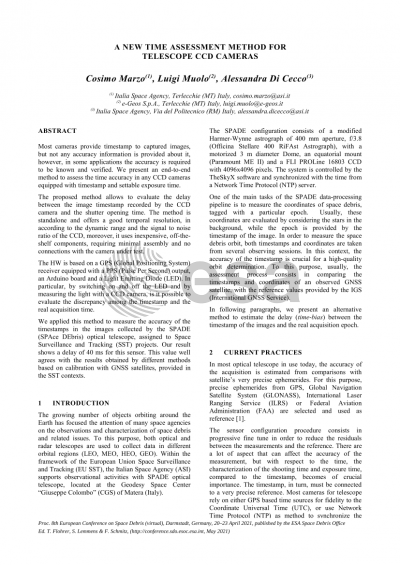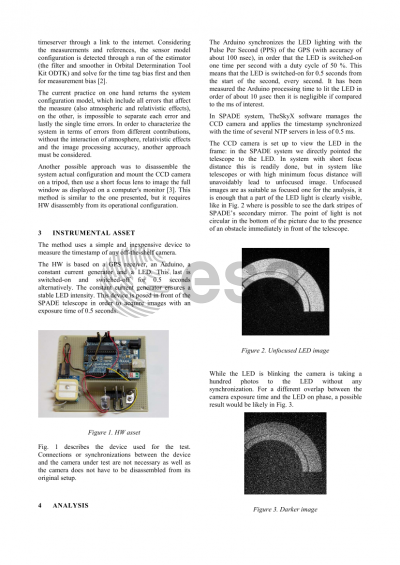Document details

Abstract
Optical telescopes are widely used in the investigation of the space debris population, for both the astrometry and photometry studies, within the Space Situational Awareness (SSA) and the Space Surveillance and Tracking (SST) projects. Most optical cameras provide timestamp to images captured, but not any accuracy information about it. In some applications, can be required to know the accuracy of image timestamp to reduce errors in subsequent calculations. We present an end-to-end method to assess the time accuracy in any CCD cameras equipped with timestamp and settable exposure time. The method determines the delay between the image timestamp, recorded by the CCD camera under test, and the corresponding and actual shutter opening time. Also, it provides the jitter of the shutter opening time and the uncertainty of exposure time used. The method does not require to have cameras with the shutter opening signal output, or triggers or any other device connected to the camera under test. Precise satellite orbits also are not required. The original use was to evaluate the accuracy of timestamps in images of an optical telescope assign to SST but the method is applicable to any cameras where accurate image timing is required. The calibration offers good temporal resolution, in according to the dynamic range and the signal to noise ratio of the CCD, moreover, it uses inexpensive, off-the-shelf components, requires minimal assembly and no connections with the camera under test. The method is based on estimating the intensity of light in a series of images on a light emitting diode (LED), which is synchronized with the time from a Global Positioning System (GPS) receiver. At each pulse per second (PPS) from GPS the LED is on for 0.5 seconds, then it is off. The CCD camera under test is configured to point to the LED, focus is not required, and to have an exposure time of 0.5 seconds. During the calibration the camera takes asynchronously a series of images on the LED. The series of images is processed to evaluate the light intensity in each. It comes that the brighter image in the series has started his exposure very close to the PPS from GPS, in way that his exposure time matches very close the LED on phase. In the same way, the darker image in the series starts his exposure very close to the LED off phase start. Images analysis produces a V-shaped curve in a x-y diagram where: on the x axis there is the time from 0 to 1 second; on the y axis there is the light intensity of images. Images are ordered in the diagram based on their light intensity and their fraction of a second in the timestamp. Estimating the distance of the bottom of the V-shaped curve from the 0.5 second point in the x-y diagram determines the delay in the CCD camera shutter opening then reported in timestamp. The time distance analysis of each image from the V-shaped curve provides the RMS of the timestamps.
Preview






